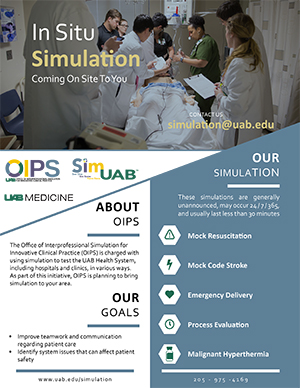 On June 20, 2018, The Office of Interprofessional Simulation had the opportunity to welcome all of the incoming residents to UAB and introduce them to a hospital culture that values patient care quality and safety. The incoming residents were given an overview of Quality and Patient Safety programs such as Code Sepsis, Infection Prevention strategies and Clinical Simulation.
On June 20, 2018, The Office of Interprofessional Simulation had the opportunity to welcome all of the incoming residents to UAB and introduce them to a hospital culture that values patient care quality and safety. The incoming residents were given an overview of Quality and Patient Safety programs such as Code Sepsis, Infection Prevention strategies and Clinical Simulation.Each resident was introduced to healthcare simulation as part of UAB’s culture of safety. They viewed a simulation prebriefing video to introduce them to interprofessional simulation as a technique for training. This video also provided context for performance expectations in various interprofessional simulations.
Key Facts
In Situ simulation(s):
is an experience that is integrated into the actual clinical environment and involves participants that are on-duty clinical providers during their actual workday
- are unannounced and may occur 24/7/365
- occur entity wide in in-patient, out-patient and non-patient care areas
- goals are to improve our teamwork and communication regarding the care of our patients and identify latent safety threats or system issues that can effect patient safety
- last < 30 min including the debrief and written evaluations
- are video-taped and quality metrics are shared with UAB Patient Safety
- may include a manikin patient- the manikin blinks, breathes, has pulses and can have most medical procedures performed on him, including defibrillation
- may include a human actor as a simulated patient
- may include an embedded simulation participant (ESP) who is present to ensure the safety of the team and the patient.
Benefits
- Enable learners to improve familiarity with work environment and processes
- Identify hazards and deficiencies in the clinical systems, the environment, and the provider team
- Improve interprofessional teamwork and communication between actual working teams
- Learning environment is identical to reality
- Instills confidence in patients’ family and friends when staff are seen practicing simulations